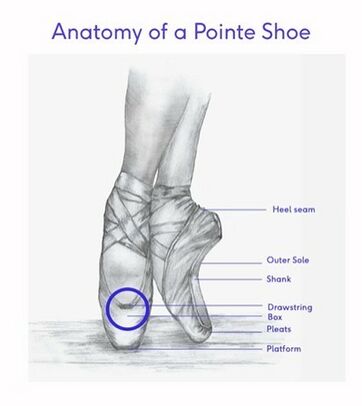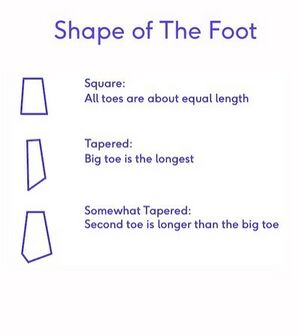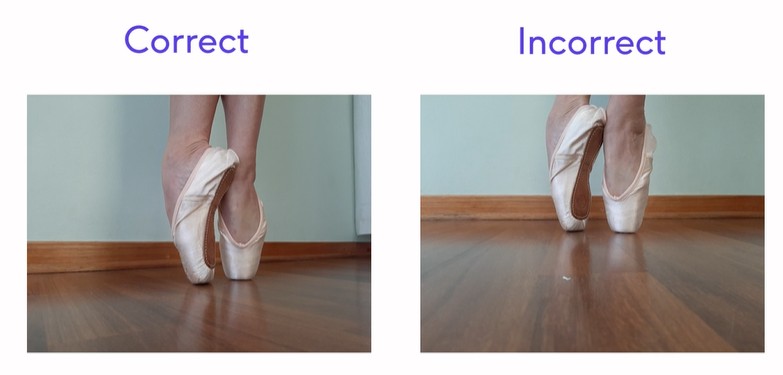Anatomy of the Pointe Shoe: Difference between revisions
Carin Hunter (talk | contribs) No edit summary |
Carin Hunter (talk | contribs) No edit summary |
||
| Line 1: | Line 1: | ||
==Introduction== | ==Introduction== | ||
*Different styles and types of pointe shoes | *Different styles and types of pointe shoes | ||
Revision as of 19:36, 27 February 2022
Introduction[edit | edit source]
- Different styles and types of pointe shoes
- Freed
- Capezio
- Teplov
- Grishko
- Gaynor Mindens
Anatomy of the pointe shoe[edit | edit source]
- Drawstring - Front or outer side
- Binding
- Toebox
- Sides or wings
- Pleats - plantar surface
- Platform
- inner sole
- outer sole
- Shank
- how many, how thick, how long
- goes according to the preference of your ballerina
- waist seams on left and right
- Back Seam
- Accessories
- Ribbons or elastics - used to secure shoe to foot
- Differences in the accessories can indicate injury (how you put them on basically will give you a good understanding of the preference of the ballerina, the years of experience on the ballerina and also potential injuries or current injuries that they have)
- two important measurements, when we talk about the toe box that we often talk about, and they are the vamp, which is from the platform over here, up to the top. So this little hard section here. This length we call the vamp. And then if we turn sideways, the top over here to the bottom over here, so this little part over here, this little measurement. That we call the profile or the crown of the pointe shoe
- Design of the pointe shoe
The outside of the pointe shoe
- Toe box -The outside of pointe shoes surrounding the forefoot, which is made from tightly packed layers of paper and fabric glued together. This gives the pointe shoe it's shape, and you want to mould the foot and the toes to the toe box
- The sole - constructed from leather, and
- The shank - comprised of leather, plastic, cardstock, or layers of glue-hardened burlap.
- The fabric ribbons and elastic bands - secure the pointe shoes to the foot.
- Breaking in pointe shoes
- 'break in' their pointe shoes, it's mostly been breaking in the shank over here. In some ballerinas, they actually just cut it off. Where others end up breaking it in for the shoe to mould against the arches of their foot.
- Ribbons and elastics
- Assessing the shoe - new ballerina
- Shank “unbroken in”
- Elastic on the heel to keep shoe on - often causes
- two reasons; one, the shank has not moulded or been broken into adequately. So one guess is that it's a newbie who's just started out and doesn't know the process or hasn't broken in their shank, and then the second part is how they've put the elastic in. So, they've attached elastic right at the top there to stop the heel from slipping off. What this does, if you attach your ribbons, this is going to bite into your Achilles tendon, and you're going to end up with Achilles issues. So, if this was a dancer, she obviously either the shoe wasn't a good fit. And then didn't bother about this. Or this is a newbie that is going to end up with an issue down the line. Your common one is either to have the elastic around here and they often will double that. So crisscrossing like that. And then this one also had a issue with it sliding off, and you'll see that they've actually sewn an elastic in the back of it, which is a lot more stable and less injury prone. The ribbons are also designed and stitched on in a specific way. So you'll find that they will either be straight or there will be slightly angled. They'll be slightly angled. And that's just following the direction of the ankle of the ballerina itself. So that'll give you a good indication as to what potentially you're looking at, how experienced the dancer is, and also the preference of the ballerina.
- Assessing the shoe - new ballerina
- Inside the pointe shoeThe Inside a pointe shoe,
the toes are squeezed together, and the toes are supported by the forefoot, midfoot and the interior sides of the toe box. Not all ground reaction forces transmit through the tips of the toes, but there is support from the forefoot system as a whole. The phalanxes are placed almost vertically in continuation with the metatarsals, which reduces the area of floor support to the first three toes.
- The pointe shoe is designed to assist the ballet steps executed whilst in plantarflexion, protecting the feet from impact forces and stabilising the performer (Walter, Docherty, & Schrader, 2011)
- Toe box must be broken in
- Wear them, dance in them, barre work in them, compress toe box with palm of hand or heel of foot, Hit plantar surface of shoe on hand or floor
- Arches need to be inline with where shank has been broken in
- Very bendy = high arch
- Very stiff = low arch
- When assessing shoe - Need to be comfortable on flat, in pointe and demi pointe
- Physio with breaking in shank - mark where arches are
- Foot shape
The toe box of the pointe shoe must be strong enough to support the dancer en pointe but be malleable enough to allow articulation of the joints of the foot and ankle.
With deterioration comes a softening of the shank and the satin outer-lining, which causes reduced rigidity of the pointe shoe.
- Square
- Tapred
- Mortons foot type
- Need to be professionally fitted
- It protects the feet from impact forces and it helps to stabilise the performer. Your toe box needs to be strong enough to support the ballerina on pointe, but it needs to be malleable enough to allow the articulation through the foot while in the pointe shoe. Deterioration, or breaking down of the pointe shoe, you lose all of these ground reaction forces and you end up creating more impact onto the soft tissues and the surrounding ligaments. The box, if this deteriorates, it becomes less rigid and less rigidity results in quite a few injuries, which can potentially happen. So when it comes to your foot shape and the pointe shoe fit. This is the job of a professional pointe shoe fitter.
- different shank lengths, shank height, shank width, vamp length, toe box length, the heights of the wings over here, the height of the platform, the height of the crown
- Shank strength will depend on your arch type and your arch flexibility. Your heel height and width, that'll have an influence on the heel section of the pointe shoe. Your vamp length will be how compressability your toes are, how long your toes are, as well as your arch flexibility. Your shoe profile height, that's also your arch type, your arch flexibility, your box shape and width, because you can see that the boxes come in very, very different shapes. height profile of this one is slightly bigger than that one. And that will also depend on your toe length the compressibility of the toes and then the foot profile height and the arch length of that.
- Need to be broken in properly so that they mould to your foot
- Done differently depending on each individual
- Can be done by wearing them, exercises and bar work, manual
- Soften the box
- Break in the shank/ soften the shank enough for your foot
- Most need to speed up the process
- Need to be ready for pointe shoes
- Importance of design
- Foot shape and the fit of the pointe shoe (professional fitters job)
- Toe shape is an uncontrollable variable.
- Why do we want to get the right fit?
- very simply because we want to get the correct load bearing points for your feet and for your body.
- too compressed, then you're going to end up with Morton's neuromas. You're going to end up with Bunyan's and calluses and probably some deviations of that hallux
- Effect on toe type and postural stability – study by Kizawa et al
Effect of toe type on postural stability
Kizawa et al, 2020
In this study, there were no significant differences in postural stability between the two toe types during bipedal-stance and demipointe.
During en-pointe, the dancers with Egyptian-type toes had greater COP displacement in the maximal medial-lateral and anterior-posterior directions compared to the dancers with square-type toes..
In the dancers with square-type toes, the more similar toe length allows more simultaneous loading of the toe-tips and creates a large surface area to support the body and load. This transmits balance ground reaction forces evenly through the two tips of the toes, resulting in smaller COP displacement than that of Egyptian-type toes. This result might be because dancers with a prominent hallux as in Egyptian-type toes cannot shorten their hallux appropriately inside the toe shoes, creating less floor contact and affecting the postural stability during pointe work.
Concluded that toe type affected postural stability in medial-lateral and anterior-posterior displacement during en-pointe. Therefore, dancers with square-type toes were more stable in pointe work than dancers with Egyptian-type toes.
- Proper fit – What to look out for in a pointe shoe as a physio
- Getting “Over the box” - good indication is wear and tear on the platform on both feet
- Stiching around the platform can give proprioceptive feedback as to where they are on the toebox
- Needs to be central wear and not more to the left vs the right
- Weak ankles - DONT want a flexible shank, want a rigid shank
- Shank should curve in towards each other so there are no gaps between your feet in 5th position as shown below
- Toe caps
- Comfort, mpuldability, shock absorption, impact, sweat absorption, cushioning
- material or silicone
- Silicone - breathable, malleable, better compressability, longer lasting
- Material - hardens with sweat from dancing
- Toes should be straight in the pointe shoe and not bent at all
- “Ideal” foot structure for on pointe – yes/no
- Ankles less prone to injury
- Toes of equal length
- High instep
- Flexible ankle
- High arches, IF they are very strong
- Ankles more prone to injury
- Uneven toe length
- Inflexible / rigid ankle
- Low instep or flat arch. Flat arch requires dancer to work n flexibility, although they usually present with good strength
- Ankles less prone to injury
- How long do pointe shoes last – study
- Approximately 20 hours of dancing
- Leather outer sole is scraped with a knife, scuffed on the floor or rubbed in rosin to prevent slipping
- How Long do pointe shoes last? (Bickle et al, 2018)
- this study was to investigate differences in foot and ankle kinetics and kinematics between new and worn pointe shoes. Fifteen professional ballet dancers completed a series of bourreés (walking en pointe) in both new and worn pointe shoes (> 20 hours wear). Force and pressure analyses determined peak ground reaction force and centre of pressure velocity. A 2D kinematic analysis determined the magnitude of mid-foot flexion and ankle plantarflexion. The worn pointe shoe caused significantly greater mid-foot flexion (P < 0.01) and ankle plantarflexion (P < 0.01) en pointe compared to the new pointe shoe. No significant changes in peak force (P = 0.855) or centre of pressure velocity (P = 0.297) were observed between conditions. The reduced structural integrity of the worn pointe shoe may be a causal factor for kinematic changes and subsequent pain and lower limb injuries in professional dancers.
- several cases, professional dancers are required to change their pointe shoes once or twice per performance, due to rapid deterioration of the shoe’s integrity (Cunningham, DiStefano, Kirjanov, Levine, & Schon, 1998; Yan et al., 2011)
- Injuries related to pointe shoes
- A worn pointe shoe with reduced structural integrity may reduce the ability of a dancer to correct postural sway, resulting in accelerated rates of muscle fatigue, ankle sprains or falls (Beynnon, Murphy, & Alosa, 2002)
- during pointe work a dancer is required to maintain full plantarflexion of the ankle, extending through the mid-foot to the toes. This is achieved predominantly by movement of the talocrural joint and to lesser extent by bones of the foot (Russell, Shave, Kruse, Koutedakis, & Wyon, 2011). A worn pointe shoe, which has increased flexibility, may no longer be able to support the foot and ankle in the required position, and as a result, hyperplantarflexion of the talocrural joint and excessive mid-foot flexion may occur.
- Considering joints and ligaments of the foot are not designed to accept excessive loading, these changes could lead to the compression of soft tissue structures (Moser, 2011) and strains in the midfoot ligaments (Russell, Kruse, Koutedakis, McEwan, & Wyon, 2010a).
- a lack of sufficient shock absorbing material
- A new pointe shoe may contribute to the attenuation of ground reaction forces (Kong, Candelaria, & Smith, 2009).
- Take home points
- Send a dancer to a professional fitter
- “Too much, too soon” - applies to moving on to pointe work. Body should be ready to accept the load with correct shoe fit, adequate ROM and strength through the range
- Need to be able to articulate through range from flat, to demi pointe, onto point, as well as reversing the movement









